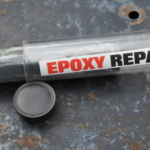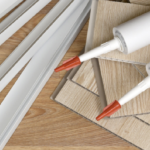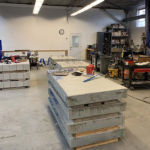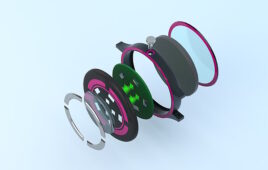
One significant advantage of polyurethane adhesives is that they’re low in volatile organic compounds (VOCs). They’re typically nearly pure monomers without solvent.
Polyurethanes are reactive adhesives named not for what they are but for what they become when cured. A polyurethane polymer is formed by extremely reactive diisocyanates combined with OH-containing molecules. Polyurethane adhesives are thermoset polymers.
The glue reacts to form a crosslinked polymer with properties unlike the starting material and a new chemical structure. Polyurethane adhesives consist of one or two parts.
A one-part polyurethane relies on atmospheric moisture as a reactant. Reaction with water causes the formation of a polyurethane polymer with the release of carbon-dioxide gas. The adhesive foams and expands as it cures from the released gas. Polyurethane expanding foams are also used for insulating and sealing large gaps, taking advantage of the foaming that occurs during curing.
Two-part polyurethanes mix a diisocyanate with a polyol immediately before use. These are typically sold as a two-cartridge system with a static mixer nozzle. Once mixed, the curing process initiates the formation of a polyurethane bond.
Most structural polyurethane adhesives do not release gas or foam during curing. But if warranted for an application, formulations that foam can be made. The flexible polyurethane chemistry allows for a range of formulations and applications.
Typically, polyurethane adhesives are extremely sticky. Prior to cure, they adhere well and coat many substrates. They also permit the bonded joints to be repositioned for several minutes during curing. The full bond strength is usually reached after about 24 hours.

Gorilla Glue is an example of a one-part polyurethane adhesive, easily found in hardware or home improvement stores.
Applications
Cured polyurethane adhesives tend to be flexible. Adhesives made using polyols can also be rubbery, but they form strong bonds on various substrates. Polyurethane adhesives find use in high-performance applications due to their resiliency. They’re unlikely to crack when under stress and will deform to maintain a strong bond.
Polyurethanes are prominently used in the construction industry but work well in other sectors. This is thanks to the durability of the bonds formed between almost any material, whether porous or non-porous. Metals, wood, concrete, brick, rubbers, cured epoxy, leather, tile, glass, and many plastics all can be bonded with polyurethane adhesives.
However, these adhesives are less effective on some plastics, notably polypropylene, polyethylene, silicones, Teflon, and waxy or oily surfaces.
One-part polyurethane adhesives and sealants are easily found on the shelves of hardware and home improvement stores. Gorilla glue and urethane wood glue are examples. These glue foam and fill wood joints, ensuring strong bonds. Foam sealant, such as the Great Stuff brand, is a polyurethane adhesive and filler.
Polyurethane construction adhesives have become more common, noted for their strength when cured and high initial tack. Water from the air is required for curing.
Although clean and dry is ideal for most glue, clean and wet is often best for polyurethane adhesives. The directions differ as to whether one or both surfaces for bonding should be dampened beforehand. It depends on the characteristics of the substrates.

Two-part polyurethane adhesives cure through the reaction of a polyol and a diisocyanate. The red and blue bars represent organic chemical structures.
One potential disadvantage of this adhesive is the shelf-life once opened because it’s susceptible to reaction with atmospheric moisture. Unused glue should be kept tightly sealed and, if possible, in a dry environment. Sunlight and high temperatures are detrimental.
Two-part polyurethane adhesives are more likely to find use in industrial sectors, such as automotive, aerospace, and manufacturing. Modern windshields are glued in place with polyurethane adhesives. They’re also commonly placed between metal panels, even if the panels are also welded. These adhesives add strength and reduce noise.
Bonding composite parts for airplanes, wind turbines, and other applications are other sectors these two-part polyurethane adhesives find use. The reactive monomers present in the polyurethane adhesive can react with hydroxyls on the substrate surface. Flame, plasma, or corona treatment can improve bonding with this type of adhesive.
Whether one or two parts, the cross-linking that occurs during curing means this polyurethane will not dissolve easily in any solvent. The window to fix or clean a sloppy application with solvent is short. Acetone is recommended for many polyurethanes, including wood glue and foam sealers. Typically, it’s best to wait until the curing is complete to mechanically remove the cured resin with a knife, scraper, or chisel.
 Applications for polyurethane adhesives are expanding because of how well they bond to different substrates. They’re used in a surprising number of applications we encounter every day.
Applications for polyurethane adhesives are expanding because of how well they bond to different substrates. They’re used in a surprising number of applications we encounter every day.
Handle with care
Isocyanates are reactive chemical species and do pose some risks. They’re potent sensitizers harmful to the skin, eyes, and mucous membranes.
Polyurethane adhesive is challenging to remove from skin and clothes, so care should be taken whenever using urethane formulations. Read the directions and wear the recommended personal protective equipment.









Tell Us What You Think!